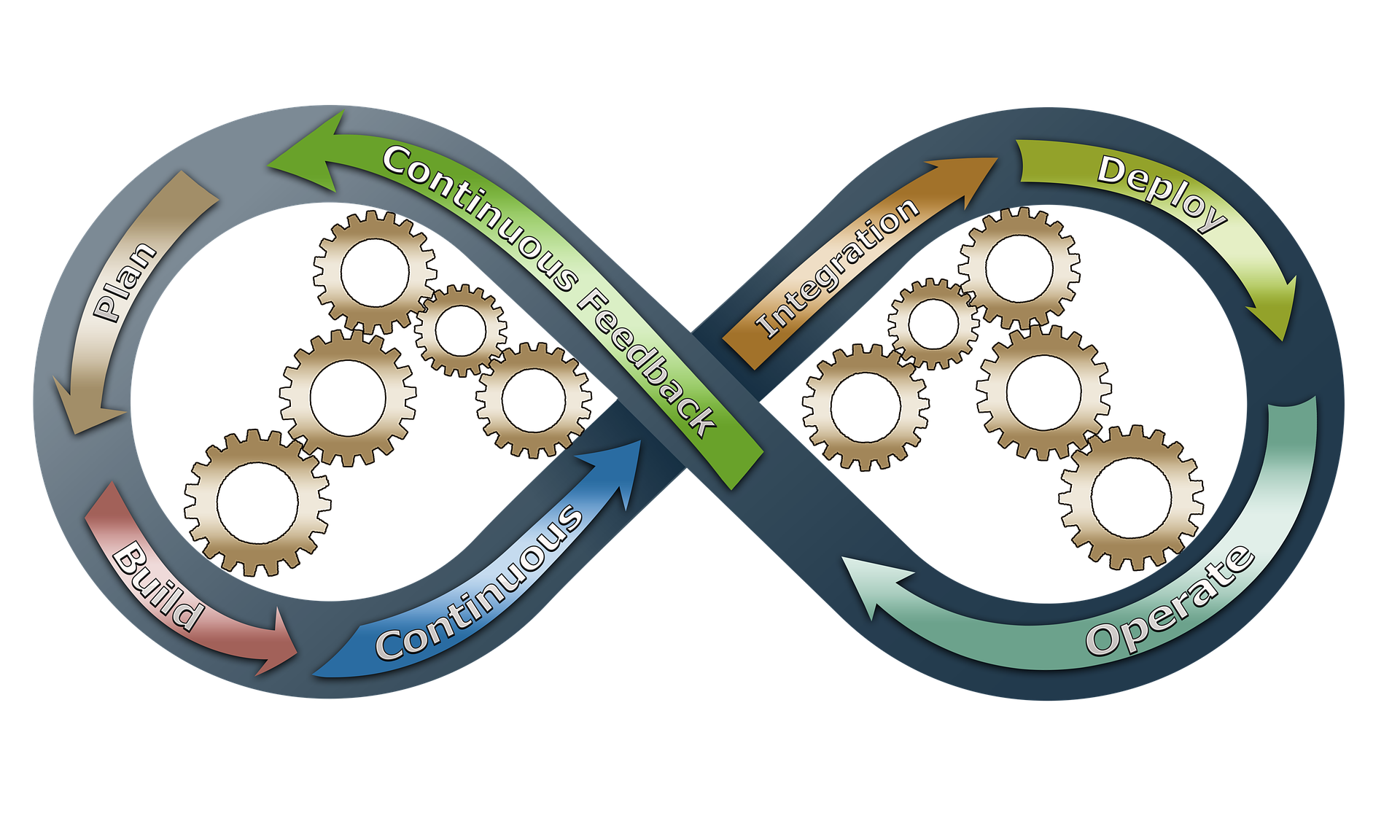Subscribe to the blog
DevOps interview questions range from the easy and obvious to the difficult and technical.
Among software developers globally, 17% say that their organization has fully embraced DevOps in 2018, up from 10% in 2017 according to Statista.
But you probably don’t need these statistics to tell you that DevOps is rapidly changing IT culture...for the better. CEOs and managers realize that DevOps help meet user expectations and they’re ready and willing to hire more people who can integrate into this new and exciting culture of collaboration.
And they’re willing to pay DevOps very well.
According to Glassdoor, DevOps engineers are earning an average salary of $143,707/yr. That’s no small potatoes. But how do you get the job in the first place?
You have to ace the interview.
That’s why we’re going to walk through a variety of DevOps interview questions in today’s post, ranging from general ones to specific questions about Ansible and TFS.
Let’s dive in.
General DevOps Engineer Interview Questions

Answering DevOps interview questions requires in-depth preparation and preparedness to impress the hiring manager.
General DevOps interview questions and answers are how most interactions with a hiring manager will start. Below, you’ll find 5 of the top questions you’ll be asked with a detailed description of the answer you should give.
1. Why is DevOps Important for Companies to Adopt?
Right away, you want to discuss market trends from the perspective of the company who’s hiring you. Put yourself in their shoes and frame the question from their point of view.
Make the point that in order for companies to stay relevant they have to constantly be innovating. DevOps shortens development cycles. Features can be released to customers much faster and you can leverage their feedback to refine and improve the application more quickly.
Swift innovation means higher quality software and customer satisfaction.
There’s also a lower failure rate attached to new releases. Without huge sets of features, developers have fewer bugs to sort out. Smaller increments of software releases lead to fewer fixes and minimal crashes.
2. What are the Advantages of DevOps?
This question is somewhat similar to the last one, but it gives you the opportunity to dig deeper into the benefits of DevOps from an organizational standpoint, not just a technical one.
Talk about how DevOps enhances the culture of software development. Rather than focusing on individual goals, teams can come together over common goals that accelerate the growth of the entire organization.
DevOps is inherently a culture of communication. More transparent interaction between developers and operations personnel creates deeper respect and trust for one another, the hallmarks of effective collaboration. These improved relations encourage experimentation, well-reasoned risk-taking, and commitment to the task at hand. All of which dramatically improves the working environment for everyone.
There’s also less downtime waiting for one team to finish something before another team can do their jobs. Processes are streamlined and seamlessly blended together.
3. Using a Real-Life Case Study, Explain How DevOps Can Be Used in a Company.
This question is actually much easier to answer than it sounds. There are numerous examples of companies killing it thanks to their adoption of DevOps.
One of the best examples of DevOps in use in real-life is Netflix.
Netflix hosts its streaming service on Amazon Web Services (AWS). The central problem for Netflix is they have to provide video streams to customers using different devices. They can’t afford to have quality impaired for a second, regardless of what their customers use for streaming.
How did they figure out a way to reduce failure as much as possible? They forced themselves to fail continuously.
Netflix created a piece of software named Chaos Monkey. Here’s how it works in their own words:
“Chaos Monkey is a service which identifies groups of systems and randomly terminates one of the systems in a group...Failures happen, and they inevitably happen when least desired.”
Instead of having faith in simple patches and making their job “easier” (like so many lazy developers would do), the DevOps crew at Netflix put themselves in an uncertain environment where unexpected outages and unreliable services were the norm.
The result?
A constant push to create better and better fault-tolerant systems which actually does make their job easier. And boy did this failure testing come in handy in 2014.
At the end of September in 2014, Amazon had to perform a maintenance update that affected 10% of their global cloud servers. The servers would have to be rebooted. Netflix uses Cassandra, and many of their nodes would be affected. But since Netflix was running Chaos Monkey on their Cassandra nodes, they were prepared to handle the “reboot apocalypse.”
According to Christos Kalantzis, Cloud Database Engineering Manager at Netflix:
“Out of our 2700+ production Cassandra nodes, 218 were rebooted. 22 Cassandra nodes were on hardware that did not reboot successfully. This led to those Cassandra nodes not coming back online. Our automation detected the failed nodes and replaced them all, with minimal human intervention. Netflix experienced 0 downtime that weekend.”
4. What is Version Control?
The obvious answer is to just define version control and move on. While you should define it, you should also mention how and why version control is used.
So first, here’s a working definition of version control you can use:
“Version control is a system that records changes to a file or set of files over time so that you can recall specific versions later.”
After defining version control, list a few of their benefits such as:
- Version control allows for greater collaboration. Every developer on the team can work on the project individually and the version control system (VCS) will merge any changes into a shared document.
- Instead of having to save multiple versions of a document or project over and over again, a VCS automatically saves past versions that you can view any time or restore if need be.
- Even with saved past versions of a document, it can be confusing to figure out exactly what was changed by someone else. A VCS solves this problem by mandating developers to write a short description of the changes they made for each version of the project.
5. What is Git?
This question is really a tag on to the question about version control since they are interrelated.
Here’s a working definition you can provide that comes straight from the horse's mouth:
“Git is a free and open source distributed version control system designed to handle everything from small to very large projects with speed and efficiency.”
After defining Git, you can list some of its key advantages:
- Git enables you to create many local branches independent of one another. You can easily switch contexts, develop role-based codelines for different purposes, and have multiple branches for each feature you’re working on.
- Git gives developers an enormous speed advantage over centralized systems since almost all of its operations happen locally.
- Git virtually guarantees the cryptographic integrity of every bit of what you work on thanks to its data model.
Ansible Interview Questions
Some hiring managers will want to test your knowledge about different software development tools. Here are a few questions about Ansible you’ll probably be asked and how to answer them.
1. What is Ansible?
This is the most obvious question you’ll be asked and you should have the answer top of mind.
Here’s one way to define Ansible:
“Ansible is an open source IT Configuration Management, Deployment & Orchestration tool.”
“Ansible is a radically simple IT automation engine that automates cloud provisioning, configuration management, application deployment, intra-service orchestration, and many other IT needs.”
You could use one of those working definitions or construct your own, depending on what you’re most comfortable with.
You should probably go further than just providing a working definition for Ansible, though. Describe other aspects of it. Like how it’s different from Puppet or Chef in that Ansible doesn’t require an agent on the remote host - it uses SSH.
Or that Ansible is written in Python and installed on the remote host’s machine, meaning you can run it from any of your computers.
2. How Does Ansible Work?
Now is your chance to explore your knowledge of Ansible and intimately describe how it works.
Start off by defining Ansible’s two types of servers:
- Controlling machines
- Nodes
Whatever machine has Ansible installed and manages the Nodes is the controlling machine.
Nodes are different hosts connected to the network.
Ansible, through the controlling machine, sends modules to nodes using SSH protocol. These modules remain on remote nodes temporarily and interact with Ansible through a JSON connection.
Ansible is a powerful tool and can handle hundreds of nodes from a single system but in some cases, you’ll need “playbooks” to execute multiple commands.
Playbooks are sets of commands in YAML file format which can carry out many tasks for you synchronously or asynchronously.
3. What are the Advantages of Using Ansible?
Ansible has quickly become highly popular due to its extensive list of features and ease of use. Here’s a ton of the many advantages of using Ansible you can talk about during your interview:
- You don’t need daemons running in the background for the nodes to connect to the controlling machines. It’s agentless.
- The nodes aren’t polling the controlling machine - reducing the overhead on the network.
- Ansible ensures more safety and security because it uses SSH and Python exclusively.
- A well-written Ansible playbook can be idempotent - preventing unforeseen byproducts on managed systems.
- Since shell scripts are so simple, you don’t need to install additional software.
- Ansible will tell you if a task succeeded, failed, or delivered an error message by urging you to name each task in the provisioning script.
TFS Interview Questions
Beyond Ansible, some hiring managers will want to test your knowledge of other platforms used in DevOps such as TFS. Here are some common questions and their answers:
1. What is TFS?
TFS stands for Team Foundation Server and it was developed by Microsoft as their on-premise version of Azure DevOps services. According to Microsoft:
“Team Foundation Server provides a set of collaborative software development tools that integrate with your existing IDE or editor thus enabling your cross-functional team to work effectively on software projects of all sizes.”
Essentially, TFS helps teams work together to deliver products quickly by creating intercommunication between developers, testers, project managers, operations, CEOs, etc. You know, basically fulfilling the goals of DevOps generally.
2. Describe TFS in Relation to Git.
If you’re asked to do this, simply compare and contrast TFS and Git like this:
- TFS supports 5 million lines of code whereas Git supports 15 million lines of code.
- TFS integrates with development environments like Visual Studio and Sharepoint while Git doesn’t support any of them.
- TFS is usually more secure because you can assign permissions to each individual file whereas Git relies on a file system.
- TFS relies on the SQL server to store data while Git uses the Distributed Version Control System (DVCS).
- TFS stores information on a central server whereas Git stores every local copy independent.
- TFS allows for manual test tracking while Git doesn’t.
- TFS requires half a day for installation while Git requires 10 minutes.
For Businesses Who Want to (Finally) Implement DevOps into Their Organization: Here’s Your Chance
Separating development from operations may have worked (OK) in the past, but in today’s complex, ever-changing software landscape, you need a way to remain flexible and cutting-edge.
That’s where DevOps comes in. It brings together all the teams who would eventually interact with a new software project and allows them to collaborate simultaneously, give and receive feedback, and speed up the development and deployment cycle.
But just like the Agile methodology, DevOps can seem too frustrating and complicated to implement for many organizations, leading them to settle for their current processes instead of trying something new.
That’s where we come in.
ATC specializes in DevOps consulting. We can help you:
- Audit your current processes, identify inefficiencies, align your team around a common end-state vision, and create an actionable plan for implementing DevOps.
- Assist you in setting up your “continuous delivery pipeline” and applying DevOps’ end to end process automation while improving security, compliance, and productivity.
- Achieve full DevOps integration in your organization and handle release management, continuous deployment, and new server setup while reducing the costs of ongoing management.
Reach out today to discover how to make DevOps work for your business.




